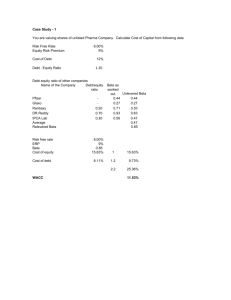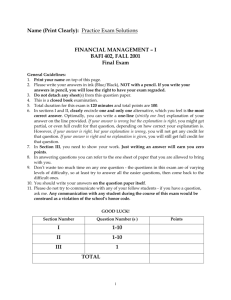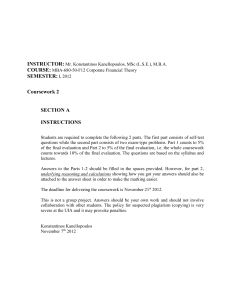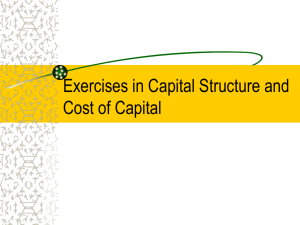Document
advertisement
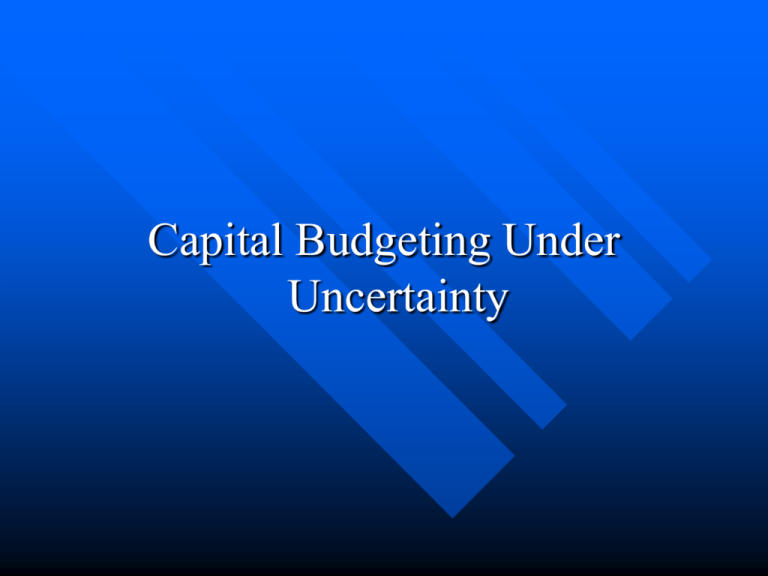
Capital Budgeting Under Uncertainty The Cost of Capital and Capital Budgeting: Some Questions A company can get cash for investment by retaining earnings or selling either debt or equity. Does it make any difference how the firm raises money in determining the cost of capital? – What is the proper discount rate when the firm uses both debt and equity? How do we find the proper discount rate when projects are risky? – How do we do capital budgeting when the project has different risk and/or a different capital structure than does the firm as a whole? Capital Budgeting Complexities Our analysis of risk and return, as summarized by the SML, can be extended to capital budgeting decisions. If the firm has no debt in its capital structure and the project being evaluated has the same (beta) systematic risk as the firm’s existing projects, then the expected return on the firm’s equity is the appropriate discount rate for the project. If the project beta differs from the firm beta then use the project beta. – Why? – How can this be estimated? Project vs. Firm Risk (All Equity Firm):Why? Expected Return project cost of capital SML • firm cost of capital • Rf Beta Firm Beta Project Beta Project Beta: How do you estimate it? In evaluating a project, you want to know the total risk of that “enterprise.” The easiest way is if it falls neatly into an industry in which there are publicly traded firms. – In this case find the enterprise or asset betas of a set of firms in the industry that most closely resemble the project, and take an average of these betas. In the case of a new project that looks nothing like existing enterprises it gets squishy. – Evaluate the cyclicality of its revenues and its operating leverage. – Do a comparable firm analysis. Cost of Capital for a Project Ralph’s firm is an all equity financed firm in the fast food industry. Ralph is considering a project in the Bio-tech industry. – – – – The 10 year bond rate is currently 4%. The historical average risk premium is 7%. The beta of Ralph’s firm = 1.1. The beta of Genzyme (GENZ) an all equity firm = 0.61. Cost of capital for the new investment is correctly calculated as: – E(RP) = 4% + 0.61 (7%) = 8.27% – Not as E(RP) = 4% + 1.1 (7%) = 11.7% Capital Budgeting Complexities If the firm has debt in the capital structure, adjustments are required. – Interest is tax deductible. Either allow for this in cash flows or alter the discount rate to reflect the presence of debt. – Financial leverage increases equity betas relative to the firm’s beta. » Which of these is estimated by the regression technique we discussed earlier? The Weighted Average Cost Of Capital (WACC) • When a firm has both debt and equity in its capital structure, the most frequent recommendation is to base the project discount rate on the weighted average cost of capital (WACC or rWACC): WACC S B rS rB (1 TC ) S B S B • where – S is the market value of the firm’s stock – B is the market value of the firm’s debt – rS is the required rate of return on the firm’s stock – rB is the required before tax rate of return on the firm’s debt – TC is the firm’s marginal tax rate Calculation of the Cost of Debt (rDebt) The before tax cost of debt can be calculated as the yield to maturity on the firm’s existing debt. Can also be found from bond ratings of companies with comparable financial structure. – Wall Street Journal – Moody’s The after tax cost of debt is the before tax cost of debt multiplied by (1-Tc), where Tc is the firm’s effective marginal tax rate. Calculation of the cost of equity (rEquity) • The cost of equity can be calculated using the Security Market Line (SML) from the CAPM. • rS= Rf+ b (E[RM]- Rf) Some choices: – Use of long-term versus short-term rate for Rf. • Practitioners usually favor the long-term rate. • Make sure you adjust the risk-premium accordingly. – Beta. • Regression or beta book. • Need to adjust the equity beta for different capital structures. WACC Example Gamma airlines is financed with 60% debt and 40% equity. Currently the YTM on Gamma bonds is 9%, and Gamma has estimated its cost of equity to be 14.5%. Gamma’s corporate tax rate is 40%. What is Gamma’s WACC? WACC = .40(14.5%) + .60(9%)(1-.40) = 9.04%. Issues: – What if the risk of the project at hand differs from that of Gamma’s past projects? – What if risk of this project is similar to that of Delta Airlines’ projects, and the 14.5% cost of equity figure was actually obtained for Delta. However, Delta’s capital structure differs from Gamma’s. Betas and Leverage We noted earlier that the beta of a portfolio is the average of the component betas. We can think of the firm’s assets as a portfolio of the debt and equity claims. From these insights it follows that: S B b Assets b Equity b Debt S B S B • Where S is the market value of the stock (equity), B is the market value of debt (borrowings), and Tc is the tax rate. • Think of the “balance sheet” representation of the firm. Beta Under Different Capital Structures In this analysis it is often assumed that the debt has a zero beta (sometimes a big simplification). Then: b Assets S b Equity S B • When taxes are considered, the understanding remains the same, but the math becomes more complicated. The result is (see sec 17.7 in RWJ): b Assets S S (1 T ) B b Equity c Points to Notice Regarding Betas and Leverage If the firm uses no debt (B=0) the equity beta and the asset beta are equal. If the firm uses debt, the equity beta is higher than the asset beta (since debt is first in line, equity is riskier than the overall firm): b Equity B (1 TC ) b Assets 1 S implies: – (1) equity holders will require a higher rate of return, – (2) when surrogate firms are used to estimate beta, adjustments for differing capital structures are needed. How to use the set of tools developed here to select discount rates for capital budgeting. The cost of capital for each project should reflect the systematic risk of that project and the capital structure of the firm (or division) taking the project. So, – Select a publicly traded company that is comparable in terms of the risk of the underlying business. – Obtain the unlevered (asset) beta of the comparable. – Obtain the corresponding project equity beta, reflecting your firm’s capital structure. – Obtain the cost of equity and cost of debt for this project at your firm. – Calculate the WACC for the project and perform NPV analysis. Example: “Un-levering” and “Re-levering” b To the process of evaluating Gamma Airlines you find: – Delta Airlines has an Equity beta of 1.215, Tc = 40%. – Delta uses 70% equity and 30% debt financing. Find the asset beta of Delta: b Assets .70 1.215 0.966 .70 .30(1 .4) – This will reflect the risk of the assets of Gamma Air. Now find the equity beta of Gamma Air .60(1 .40) 1.835 0.9661 .40 If Delta’s and Gamma’s capital structures are different, their costs of equity will be different: 18.85% not 14.5%. Summary: Risk, Return, and Discount Rates Some risk can be diversified, some cannot. ‘Beta’ coefficients measure systematic risk. We expect systematic risk to earn a risk premium in equilibrium but that diversifiable risk will not. The CAPM (and particularly the SML) is a simple model capturing important insights regarding risk and diversification. Discount rates for projects should reflect the systematic risk of the project (not necessarily that of the firm) and the capital structure of the firm or division (not necessarily the financing of the project itself).

